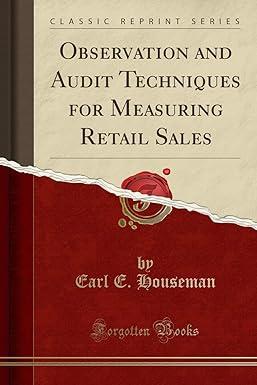Question
Generic Motors Corporation has two product lines, A and B. Its revenue and costs for last year is as follows: Product A Product B Total
Generic Motors Corporation has two product lines, A and B. Its revenue and costs for last year is as follows:
| Product A | Product B | Total | |
| sales volume (units) | 100 | 200 | 300 |
| Revenue | $6,000 | $30,000 | $36,000 |
| Costs: | |||
| direct materials | $1,200 | $6,000 | $7,200 |
| direct labor | $3,000 | $12,000 | $15,000 |
| OH costs | $11,700 | ||
| Profit | $2,100 |
Generic Motors uses ABC to allocate the overhead costs. It examined the main activities in the firm, and decided to break up the total overhead costs of $11,700 into 3 cost pools: * "labor-related" - the total cost in this pool is $3,000, allocated based on direct labor dollars * "sales-related" - the total cost in this pool is $2,700, allocated based on number of units * "production setups" - the total cost in this pool is $6,000, allocated based on the number of production setups. Product A requires 10 setups. Product B requires is 40 setups. Required: a) for each cost pool, compute the activity rate and the amounts allocated to product A and product B. (hint: The amounts allocated to A and B from each pool should add up to the total cost in that pool. To allocate the costs in the "production setups" pool, you will have to compute the number of batches. If the total number of batches for A and B does not add up to 50, you are doing something wrong). * "labor-related" pool: activity rate = $ per DL$ Labor-related OH costs allocated to A = $ Labor_related OH costs allocated to B = $ * "sales-related" pool: activity rate = $ per unit Sales-related OH costs allocated to A = $ Sales_related OH costs allocated to B = $ * "production setups" pool: activity rate = $ per setup Production setups OH costs allocated to A = $ Production setups OH costs allocated to B = $ b) using the allocated OH costs from (a), compute the profit margin for product A and product B. If you get a negative number, enter it with a minus sign, i.e., enter negative $100 as -100, not ($100) profit margin for A = $ profit margin for B = $
Step by Step Solution
There are 3 Steps involved in it
Step: 1

Get Instant Access to Expert-Tailored Solutions
See step-by-step solutions with expert insights and AI powered tools for academic success
Step: 2

Step: 3

Ace Your Homework with AI
Get the answers you need in no time with our AI-driven, step-by-step assistance
Get Started


